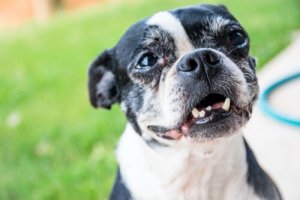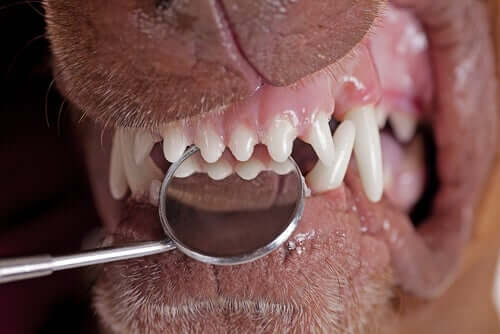Gum Disease and Missing Teeth in Older Dogs


Written and verified by the biologist Paloma de los Milagros
Usually, older dogs lose their teeth due to the normal aging process, although poor hygiene habits are also responsible for gum disease and could speed up the process.
Just as with humans, adult dogs are more susceptible to disease. They also become obese, their energy decreases, their vision decays and they endure cavities, tooth decay, and gum disease.
An adult dog with a full denture will have 20 upper teeth and 22 lower ones. However, it’s rare for them to conserve them all. This is because preventive oral hygiene is still not widespread among animals’ owners.
Once adult dogs lose their teeth, they require greater veterinary control to avoid possible infections and even the loss of more teeth. Consulting a veterinarian is crucial here but so is the owners’ commitment. They alone are responsible for ensuring their furry companion’s regular health checks and cleaning sessions as these are important for an animal’s well-being.
Factors that lead to gum disease
Even though they can suffer from dental disease at any stage of life, it is much more frequent in old age. The reason is that gum disease together with natural physiological wear and poor preventive care are a bad combination.

Some of the factors that lead to the loss of teeth in older dogs are:
- Gingivitis. This is the irritation and inflammation of the gums due to the presence of bacterial plaque. Generally, it’s the result of poor oral hygiene, although it can be due to genetic and nutritional factors as well. It doesn’t necessarily affect the teeth in the initial stages and you can reverse it with a deep dental cleaning session. However, it’ll worsen if you ignore it and could lead to bad breath and general pain, which in turn will lead to periodontitis.
- Periodontitis. Here, the tissue damage worsens and the infection spreads to the lateral ligaments and dental bones. It usually appears after leaving bacterial plaque, tartar, and untreated gingivitis for a long period of time. This mostly affects dogs between four and six years of age. The condition is now irreversible and causes permanent loss of dental support. However, it’ll lead to the loss of teeth if left untreated.
Endodontic disease
- Endodontic disease. This is a condition that weakens the inside of a tooth as a result of external trauma, enamel abnormalities, or cavities. Its most common symptoms are reddish to purplish teeth, and pain or facial swelling, which could result in a dental abscess.
- Other factors. Developmental anomalies such as an incorrect bite or the presence of buried teeth. And also the quality of the enamel or improper feeding can damage oral health. In addition, there are genetic factors that play a role in it. In fact, certain small breeds are more prone to suffer dental losses.
If an adult dog loses its teeth

Most people don’t notice the loss of teeth in their dogs. This is because, unless their dental pieces are considerably large or there are obvious symptoms, an owner won’t concern themselves with their pets’ teeth.
Generally, veterinarians recommend strict hygiene, periodic check-ups, and tartar build-up removal as preventive measures when a dog loses one or two teeth.
In some cases, poorly-treated infections might spread and weaken larger dental pieces. Losing several significant teeth or other injuries would make it difficult for an animal to eat. So, a professional will evaluate whether they need surgical intervention or just a change in their diet.
Proper care of the dental health of a young dog will determine their quality of life when they grow older. Therefore, the owner’s involvement together with an adequate diet and veterinary supervision are the foundation of your animal’s well-being.
Usually, older dogs lose their teeth due to the normal aging process, although poor hygiene habits are also responsible for gum disease and could speed up the process.
Just as with humans, adult dogs are more susceptible to disease. They also become obese, their energy decreases, their vision decays and they endure cavities, tooth decay, and gum disease.
An adult dog with a full denture will have 20 upper teeth and 22 lower ones. However, it’s rare for them to conserve them all. This is because preventive oral hygiene is still not widespread among animals’ owners.
Once adult dogs lose their teeth, they require greater veterinary control to avoid possible infections and even the loss of more teeth. Consulting a veterinarian is crucial here but so is the owners’ commitment. They alone are responsible for ensuring their furry companion’s regular health checks and cleaning sessions as these are important for an animal’s well-being.
Factors that lead to gum disease
Even though they can suffer from dental disease at any stage of life, it is much more frequent in old age. The reason is that gum disease together with natural physiological wear and poor preventive care are a bad combination.

Some of the factors that lead to the loss of teeth in older dogs are:
- Gingivitis. This is the irritation and inflammation of the gums due to the presence of bacterial plaque. Generally, it’s the result of poor oral hygiene, although it can be due to genetic and nutritional factors as well. It doesn’t necessarily affect the teeth in the initial stages and you can reverse it with a deep dental cleaning session. However, it’ll worsen if you ignore it and could lead to bad breath and general pain, which in turn will lead to periodontitis.
- Periodontitis. Here, the tissue damage worsens and the infection spreads to the lateral ligaments and dental bones. It usually appears after leaving bacterial plaque, tartar, and untreated gingivitis for a long period of time. This mostly affects dogs between four and six years of age. The condition is now irreversible and causes permanent loss of dental support. However, it’ll lead to the loss of teeth if left untreated.
Endodontic disease
- Endodontic disease. This is a condition that weakens the inside of a tooth as a result of external trauma, enamel abnormalities, or cavities. Its most common symptoms are reddish to purplish teeth, and pain or facial swelling, which could result in a dental abscess.
- Other factors. Developmental anomalies such as an incorrect bite or the presence of buried teeth. And also the quality of the enamel or improper feeding can damage oral health. In addition, there are genetic factors that play a role in it. In fact, certain small breeds are more prone to suffer dental losses.
If an adult dog loses its teeth

Most people don’t notice the loss of teeth in their dogs. This is because, unless their dental pieces are considerably large or there are obvious symptoms, an owner won’t concern themselves with their pets’ teeth.
Generally, veterinarians recommend strict hygiene, periodic check-ups, and tartar build-up removal as preventive measures when a dog loses one or two teeth.
In some cases, poorly-treated infections might spread and weaken larger dental pieces. Losing several significant teeth or other injuries would make it difficult for an animal to eat. So, a professional will evaluate whether they need surgical intervention or just a change in their diet.
Proper care of the dental health of a young dog will determine their quality of life when they grow older. Therefore, the owner’s involvement together with an adequate diet and veterinary supervision are the foundation of your animal’s well-being.
All cited sources were thoroughly reviewed by our team to ensure their quality, reliability, currency, and validity. The bibliography of this article was considered reliable and of academic or scientific accuracy.
- Hickling. (2018). Centennial Animal Hospital. My Dog Lost Its Tooth. What Should I Do? Recuperado de https://www.centennialanimalhospital.com/dog-lost-tooth/
- Reiter, A.M. (S.f). Merck Manual Veterinary Manual. Dental Disorders of Dogs. Recuperado de https://www.merckvetmanual.com/dog-owners/digestive-disorders-of-dogs/dental-disorders-of-dogs
- World Small Animal Veterinary Association (2006) Guías dentales de la asociación mundial de veterinarios de pequeños animales. Recuperado el 16 de febrero de 2022, disponible en: https://wsava.org/wp-content/uploads/2020/01/WSAVA-Dental-Guidelines-Spanish.pdf
- Henniet, P. (2016) Nutrición y salud oral en el perro. Recuperado el 16 de febrero de 2022, disponible en: https://vetacademy.royalcanin.es/wp-content/uploads/2019/11/Cap-12-Nutricion-y-salud-oral-en-el-perro.pdf
This text is provided for informational purposes only and does not replace consultation with a professional. If in doubt, consult your specialist.








